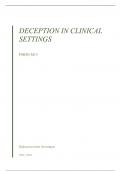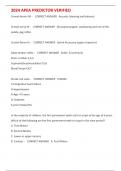DECEPTION IN CLINICAL
SETTINGS
PSB3E-M13
Rijksuniversiteit Groningen
2023 | 2024
,1
,Chapter 1 (Rogers) – An introduction to response styles
Introduction
Even the most involved clients may intentionally conceal and distort important data about
themselves
Outpatient clients sometimes did not divulge personal matters related to sexual
experiences, substance abuse, and relationship experiences
Deception is common in therapy, especially in minimizing symptoms or overstating
the effectiveness of therapy
Deception in relationships is often a thing, and partners believe that they are better in
fooling their partner instead of the other way around
In the workplace, a lot of mental disorders are concealed
Two key implications of the study of Ellison et al. were:
Decisions about response styles are often rational and multidetermined (deceive or
disclose)
These decisions are often individualized responses to interpersonal variables (good
friend) of situational demands (explanation of absence)
Employees can either disclose, conceal, or signal about themselves and personal experiences.
Sometimes in one context people will conceal something while in the other context they are
very open about it
In forensic context clients may response to the adversarial effects of litigation in which
their credibility is implicitly questioned – lexogenic effects
All individuals fall short of full and accurate self-disclosure, irrespective of the social
context
As well as clients, mental health professionals are often not fully forthcoming with clients
about their assessment and treatment methods themselves
One reasoned approach would be to document consequential deceptions and
distortions
The general issue of inconsequential deceptions should be considered carefully
- Taint hypothesis: any evidence of nongenuine responding is likely to signal a
broader but presently undetected dissimulation. Therefore, practitioners have a
professional responsibility to document any observed, even if isolated,
deceptions.
- Beyond-reasonable-doubt standard: invoking the stringent standard of proof in
criminal trials, only conclusive evidence of a response style, such as feigning,
should be reported.
Practitioners should decide based on a case-by-case evaluating if it is worth it to report
and document signs of deception
Fundamentals of response styles
A common error in determination of response styles is the overspecification
Criminal offenders are frequently miscategorized as malingerers simply because of
their manipulative behaviour
Practitioners approach this diagnostic classification by trying to determine which
specific response style fits the data, even if the data is inconclusive or conflicting
2
, Recommended approach is to make an explicit decision between nonspecific/general
response styles and specific
Nonspecific terms:
Unreliability – raises questions about the accuracy of reported information, especially
useful when faced with conflicting data
Nondisclosure – the withholding of information
Self-disclosure – how much individuals reveal about themselves
Deception – all-encompassing term to describe any consequential attempts by
individuals to distort or misrepresent their self-reporting
Dissimulation – describes a wide range of deliberate distortions or misrepresentations
of psychological symptoms
Overstated psychopathology terms:
Malingering – the intentional production of false or grossly exaggerated physical or
psychological symptoms, motivated by external incentives
Factious presentations – the intentional production or feigning of symptoms that is
motivated by the desire to assume a sick role, the deceptive behaviour is evident even
in the absence of obvious external rewards
Feigning – the deliberate fabrication or gross exaggeration of psychological or
physical symptoms, without any assumptions about its goals
Three terms to avoid in clinical and forensic psychology:
Suboptimal effort (incomplete or submaximal effort) – is sometimes misused as a
proxy for malingering
Overreporting – unexpectedly high level of item endorsement, sometimes this is
equated with feigning
Secondary gain – does not have a clear definition, which is essentially the problem
Three terms used to describe specific response styles that are associated with simulated
adjustment:
Defensiveness – the polar opposite of malingering, the deliberate denial or gross
minimization of physical and/or psychological symptoms
Social desirability – pervasive tendency for certain individuals to present themselves
in the most favourable manner relative to social norms, both the denial of negative
characteristics and the attribution of positive qualities
Impression management – deliberate efforts to control others’ perceptions of an
individual, its purpose may range from maximizing social outcomes to the portrayal of
a desired identity (more situationally driven)
Other response styles:
Irrelevant responding – the individual does not become psychologically engaged in
the assignment process
Random responding – subset of irrelevant responding based entirely on chance
Acquiescent responding – ‘yea-saying’
Disacquiescent responding – ‘naysaying’
Role assumption – may occasionally assume the role or character of another person in
responding to psychological measures
Hybrid responding – the use of more than one response style
3
,The domains of dissimulation are: (1) feigned mental disorders, (2) feigned cognitive abilities,
and (3) feigned medical complaints/symptoms
Malingering is unique among response styles in its number of associated myths and
misconceptions, common misconceptions are:
Malingering is rare, which is untrue because some clinicians actually ignore the
possibility of malingering
Malingering is a static response style, someone who has malingered before does not
have to malinger all the time
Malingering is an antisocial act by an antisocial person
Deception is evidence of malingering
Malingering is similar to the iceberg phenomenon, based on the assumption that any
evidence of malingering is enough for a classification
Malingering precludes genuine disorders
Syndrome-specific feigning scales measure syndrome-specific malingering
Malingering has stable base rates
Clinical and research models
Because most response styles are conceptualized as deliberate efforts, individual motivations
become a central concern. The motivational basis for response styles (explanatory models)
has far-reaching implications for clinical and forensic practice
Often, selection of a particular response style is based on the options available and the
desired outcome
The pathogenic model conceptualizes an underlying disorder as motivating the
malingered presentation. A distinctive feature of this model is the further deterioration
of their conditions, which ensues the uncontrollability of the feigning
The criminological models underlying logic is that malingering is typically an
antisocial act that is likely to be committed by antisocial persons. The fundamental
problem of this model is that it relies on common rather than distinguishing
characteristics of malingering
The predominant predicted-utility model encompasses that simulators may attempt to
maximize the predicted utility of their effort by using both overstated pathology and
simulated adjustment, the latter may serve two-related goals: (1) enhance the
credibility of the disability claim, and (2) emphasize the magnitude of the purported
loss
Overview of research designs:
Simulation design – excellent internal validity, weak external validity. Standard design
of an experiment, with randomized assignment to conditions and a control group:
important is the use of a relevant, operationalized, clinical comparison sample
Known-groups comparisons – The objective is the establishment of highly accurate (≥
90%) independent classifications of known groups in clinical or other professional
settings. Strong external validity, weak internal validity.
Differential prevalence design – based on assumed incentives, greater numbers of a
broadly defined group are presumed to have a specific response style when compared
to a second group. Both internal and external validity are weak to moderate
Partial criterion – by using multiple scales or indicators, researchers seek to increase
the likelihood of an accurate classification. Internal validity is weak, external validity
is moderately strong when conducted with the right samples.
4
,Chapter 5 (Rogers) – Syndromes associated with deception
Introduction
Several features about deception
Deception is a multidimensional construct that manifests differently across situations
and setting
Deception is not taxonic, it should be viewed as a dimensional construct that can
change in direction and intensity
Deception is frequently adaptive but not always
Individuals who engage in deceptive behaviours are not always insightful and aware
of their reasons for deceiving
Challenges and pitfalls when evaluating malingering and deception
Relying on the factors the DSM-5 classifies for malingering could be a problem in itself, and
can lead to a large number of false-positives
These indicators include background, setting, discrepancy, and assessment attitude;
these screening indicators are outdated and poorly validated
In evaluating feigning and related response styles, several conceptual issues warrant
consideration
- Evaluators must carefully consider examinees’ motivations
- Clinicians must not equate isolated test results with a classification of feigning
or malingering
- The behaviours associated with malingering are not taxonic, subtypes of
malingering can be distinguished from pure malingering (total fabrication) to
false imputation (no exaggeration but misattributing symptoms to a
compensable cause)
- Clinicians should consider explanatory models of malingering; clinicians must
be aware of multiple determinants of motivations related of feigning and
deceptive behaviours
- Clinicians, inasmuch as possible, must be exacting their use of language
Evaluating deception and malingering are complicated endeavours that require a sophisticated
understanding of response styles, knowledge of strengths and limitations of objective
measures, and the willingness to explore motivations as they relate to deception
There is pressure on clinicians to find malingering
Cultural factors complicate the process of detecting deception
5
, DSM-5 diagnoses associated with deception
Clinicians in general must be aware of the multiple ways deception can be manifested as a
part of psychopathology
Motivations for deception may vary; clinicians may describe a malevolent intention
when in reality it may be unconscious or simply adaptive
Oppositional defiant and conduct disorders
Diagnostic criteria in CD explicitly place deceitfulness as part of the disorder with
respect to falsehood and conning
- New DSM-5 criteria also allow for a specifier regarding whether behaviours
include limited prosocial emotions, including lack of remorse and presences of
callousness
The deception in ODD is often manifested in poor attitudes displayed towards
authority figures
- In tests measuring ODD, deception is often part of the items construct
Deceptions also relate to sexual offending behaviour with adolescents
- Deception and lying in adolescent sex offenders can be secondary to several
factors including embarrassment, trying to get away with it, or minimizing
their own histories of victimization
6





